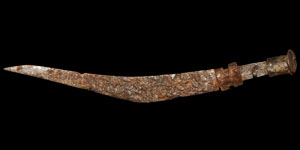Old toponyms and some personal names.
Thracian.
Zerynthus was a town of the Apsynthii, in Thrace that is the site of Zerynthius, a temple of Apollo, and Zerynthia, a cave sacred to Hecate.
Etymology.IE;ghwer,Old Church Slav-Zverъ,Lithuanian zveriš all "wild beast"
Zaldapa.Etymology IE; Ghold.Old Church Slav-Zlato,Goth Gulp,all with meaning Gold.
Beodizos-diza is the meaning of fortress in Thracian found among Thracian settlements,perhaps in it's original form,avestan Daeza "wall",Slav Zida instead Diza "wall" verb Zida,Zid "building a wall" compare with Beograd the Slavic meaning of fortress today Grad,White Fortress,City.
Personal name;Saecus,Zaecethures,Zaecaepor.Old church Slav-Zajecъ "hare" Latin haedus "young he-goat"
Thracian settlements with the ending "Dama" Duridanov connect it with the Sanskrit Dama meaning "home" settlement,the common Slavic word for home is "Dom" Doma-home
Thracian Bago-God,Slavonic-Bog
Settlements-Berge,Brega,Bergule.Slavonic meaning Breg hill,slope,mountain,Blg-Bereg.German,Russian Berg with same meaning.
Perun's wife god of thunder Dodola and her ritual;
The custom is known by two names, mostly spelled Dodola (dodole, dudula, dudulica, dodolă) and Perperuna (peperuda, peperuna, perperuna, prporuša, preporuša, păpărudă, pirpirună). Both names are used by the South Slavs and Romanians.
The name Perperuna is identified as a feminine personification of the great god Perun.Thracian anthroponyms (personal names) and toponyms (place names), such as Doidalsos, Doidalses, Dydalsos, Dudis, Doudoupes,in Greece exist Dodona.Compare with today Bulgarian names today and some other Slavic-Dado,Dido,Dilo and of course the ritual itself Dodola.
Slavic god of thunder Perun Thracian Perkon/Perkun.
Thracian.
Zerynthus was a town of the Apsynthii, in Thrace that is the site of Zerynthius, a temple of Apollo, and Zerynthia, a cave sacred to Hecate.
Etymology.IE;ghwer,Old Church Slav-Zverъ,Lithuanian zveriš all "wild beast"
Zaldapa.Etymology IE; Ghold.Old Church Slav-Zlato,Goth Gulp,all with meaning Gold.
Beodizos-diza is the meaning of fortress in Thracian found among Thracian settlements,perhaps in it's original form,avestan Daeza "wall",Slav Zida instead Diza "wall" verb Zida,Zid "building a wall" compare with Beograd the Slavic meaning of fortress today Grad,White Fortress,City.
Personal name;Saecus,Zaecethures,Zaecaepor.Old church Slav-Zajecъ "hare" Latin haedus "young he-goat"
Thracian settlements with the ending "Dama" Duridanov connect it with the Sanskrit Dama meaning "home" settlement,the common Slavic word for home is "Dom" Doma-home
Thracian Bago-God,Slavonic-Bog
Settlements-Berge,Brega,Bergule.Slavonic meaning Breg hill,slope,mountain,Blg-Bereg.German,Russian Berg with same meaning.
Perun's wife god of thunder Dodola and her ritual;
The custom is known by two names, mostly spelled Dodola (dodole, dudula, dudulica, dodolă) and Perperuna (peperuda, peperuna, perperuna, prporuša, preporuša, păpărudă, pirpirună). Both names are used by the South Slavs and Romanians.
The name Perperuna is identified as a feminine personification of the great god Perun.Thracian anthroponyms (personal names) and toponyms (place names), such as Doidalsos, Doidalses, Dydalsos, Dudis, Doudoupes,in Greece exist Dodona.Compare with today Bulgarian names today and some other Slavic-Dado,Dido,Dilo and of course the ritual itself Dodola.
Slavic god of thunder Perun Thracian Perkon/Perkun.
Last edited:













